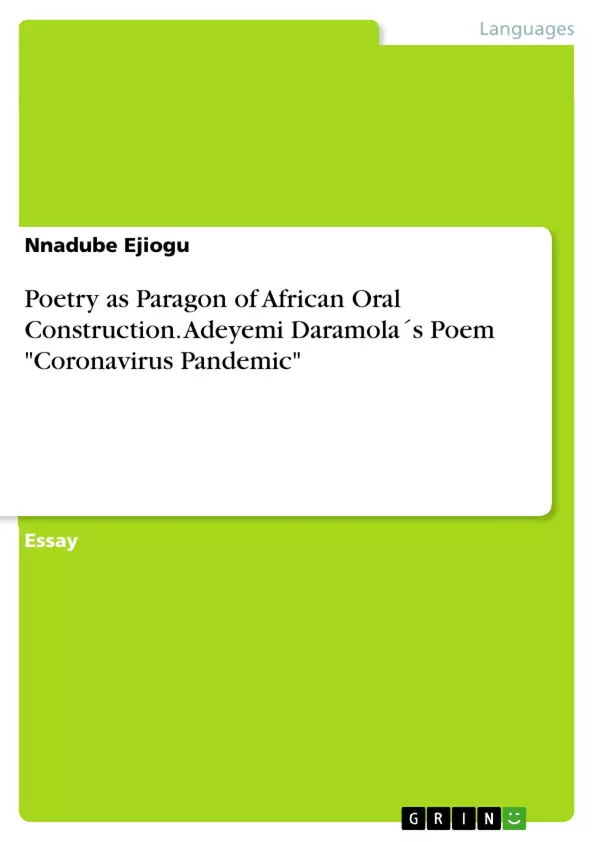This paper aims to answer the question of how Adeymi Daramola´s poem "Coronavirus Pandemic" serves as a paragon for African oral Construction on more general basis.
Poetry continues to provide the place of mirroring the existential reality of the society. The exactitude in this is what animates the architecture of Adeyemi Daramola's "Coronavirus Pandemic." Admittedly, it has shamelessly but viciously become the metaphorical clog in the wheels of our global collective progress. This global issue is gradually serving as a raw material for literature, validating the truth that literature reflects the society. There is no gainsaying that there is a symbiotic relationship between the pair so that what affects one, quite naturally, impinges on the other. Without doubt, the situation has served as a tool in the construction of Adeyemi Daramola's "Coronavirus Pandemic."
Daramola, through his poem, lends his voice to the numerous voices that have registered their concern on the influx of the virus and its consequential effect. The poet reaches into the vast repository of oral literature in providing an African interpretation of a Western-named global pandemic experience. He aesthetically weaves traditional nuances into the poem with a polish of sound, while rhythmically and linguistically nativizing the piece, touching base with African orality conventions as he attempts to address an existing reality of a globally shared horrifying experience. Given this schema, this paper is bound to the bane of using the analytical tool of orality in appreciating Daramola's artistic craft.
Table of Contents
- INTRODUCTION.
- ORAL PRAXIS AND THE MUSICAL ESSENCE.
- AESTHETICING LANGUAGE.
- THE ORATURE-NATURE NEXUS IN "CORONAVIRUS PANDEMIC"
- ORO-DARAMOLA STYLISTIC SEDUCTION.
- CONCLUSION
Objectives and Key Themes
The purpose of this paper is to analyze Adeyemi Daramola's poem "Coronavirus Pandemic" through the lens of African oral tradition. The paper aims to demonstrate how Daramola's use of oral techniques and aesthetics contribute to a distinct African interpretation of the global pandemic experience.
- The impact of the Coronavirus pandemic on global society
- The role of poetry in reflecting societal realities
- The significance of African oral tradition in contemporary poetry
- The blending of written and oral modes in poetry
- The importance of decolonizing African literature
Chapter Summaries
The introduction sets the stage for the paper by outlining the impact of the Coronavirus pandemic and highlighting the close relationship between poetry and society. It then explores the historical and cultural significance of oral tradition in Nigeria and African literature.
The following chapters delve into the specific techniques and themes found in Daramola's "Coronavirus Pandemic." This includes an analysis of the poem's musicality, language, and its engagement with African oral traditions.
Keywords
The key concepts explored in this paper include the Coronavirus pandemic, COVID-19, African orature, oral literature, Adeyemi Daramola, poetry, and African literature.
- Citar trabajo
- Nnadube Ejiogu (Autor), 2020, Poetry as Paragon of African Oral Construction. Adeyemi Daramola´s Poem "Coronavirus Pandemic", Múnich, GRIN Verlag, https://www.grin.com/document/540527



